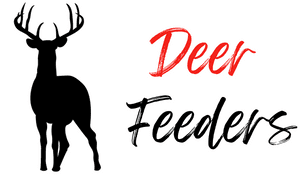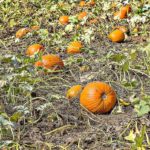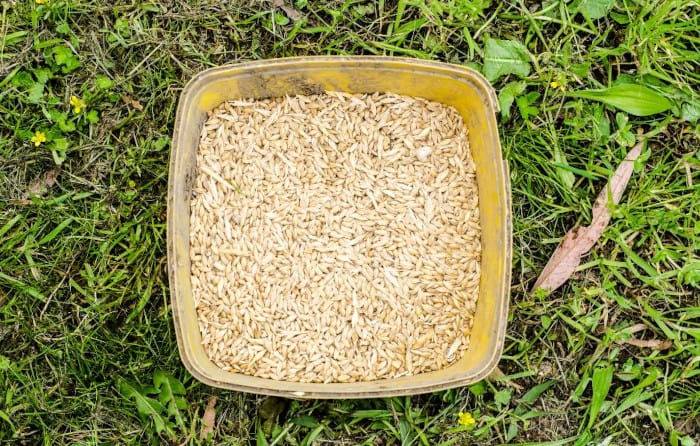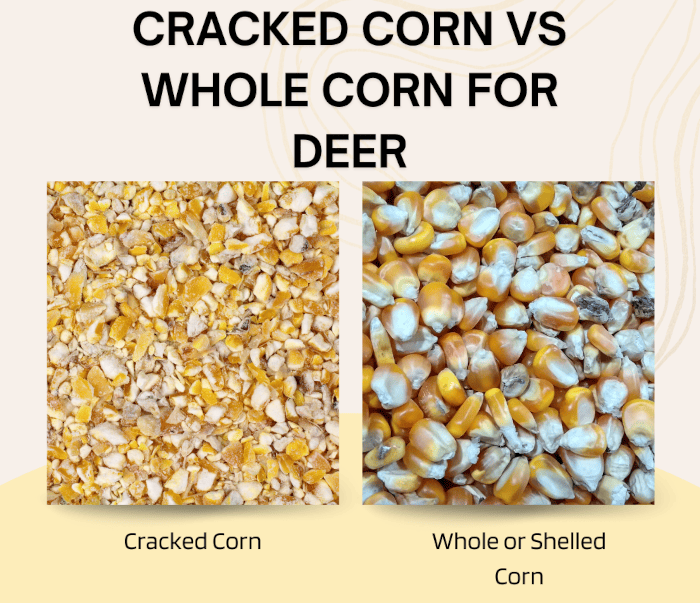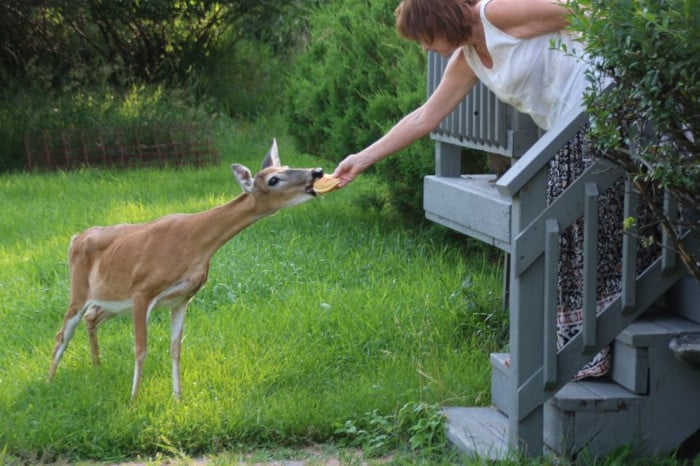Deer feeders are a subject of much debate in the deer hunting community. There are many opinions on whether or not deer feeding stations will really benefit your chances at harvesting a mature white-tailed buck. One concern that hunters commonly have with deer feeding stations is the following: do automatic deer feeders scare deer away?
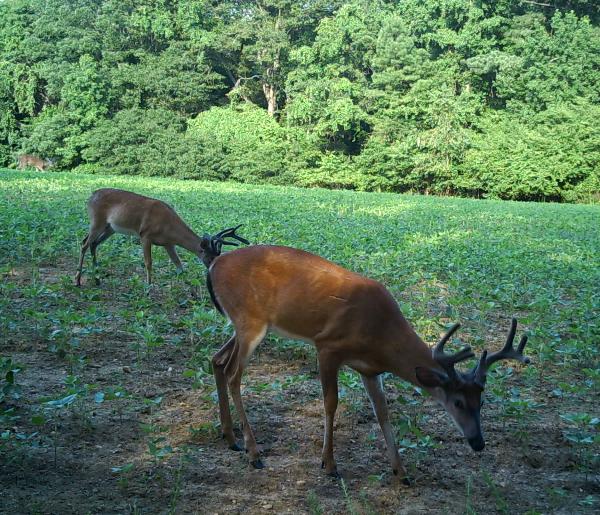
If you do any research on that topic online, you will likely see a wide variety of opinions on the subject. Some hunters and deer biologists say that mature bucks won’t come near automatic, spin type feeders. In contrast, others report seeing several mature bucks feeding automated spin feeder locations all the time. Honestly, the truth probably lies somewhere in between.
Unfortunately, the answer to the question is not strictly black and white because there isn’t a clear yes or no answer, and the question is extremely broad with very few parameters. I’m going to try to answer the question based on the following information:
- My personal deer hunting experience.
- My experiences with my deer feeding stations and trail camera data
- My training in feeders from feeder brands
I’d also like to add a caveat here. I predominantly hunt in central and SE North Carolina, so my experiences with whitetail deer are based on what I see and have seen in those areas. However, if you live and hunt in other parts of the U.S., your experiences with mature deer visiting a feeder may be completely different than mine.
Defining an Automatic Deer Feeder
So that we are all on the same page as you read this information, I define an “automatic deer feeder” as a feeder that uses a spin cast or broadcast system to throw feed at a specific time using a timer.
Most of these feeder styles are tripod models built with three legs that keep the feeder body several feet off the ground (which is one reason they are also commonly called tripod feeders). There are also hanging-style automatic feeders that are usually mounted on tree limbs, and I’ll share my experiences with those later in this article.
Different Answers for Mature Bucks versus Does
Before we get too far down this rabbit hole, I would like to point out that the original question being asked was “do automatic deer feeders scare deer?” but my experience has been that what most hunters are really asking about is whether or not an automatic feeder will scare away a mature buck.

If you split the deer into sexes, then the answer to the original question changes a bit. My experience over the years has been that does, and young bucks have no problem feeding at an automatic deer feeding station. I see does and immature bucks feeding at timed released feeder sites all the time on my trail cameras.
Occasionally, I also see mature bucks at an automatic feeder, but it’s not common. I do see mature bucks on camera eating at feeding stations, but the type or style of feeder seems to matter, and we’ll get more into that later on in this post.
So, to recap, I routinely see does and young bucks on camera at auto spin feeders but only occasionally see any mature bucks at those same type of feeders. Again, the question posed was restricted to automatic or timer-controlled feeders, so I’m sticking with that parameter.
The Complicated Answer with Mature Bucks
To really dive into the relationship between mature bucks and feeders, it’s essential to understand the yearly cycle of a buck as that cycle can play a role in when and where it will visit or feed at a deer feeding station.
I typically break a buck’s yearly cycle into 3 phases:
- Before the Rut (Or Pre-Rut)
- During the Rut
- After the Rut (Commonly called Post Rut)
I bring up these phases as a buck’s daily habits change significantly during these phases, and those changes can play a significant role in the chances of seeing a mature buck at a feeder.
What is the Rut, and Why is It Important?
If you’re new to deer hunting, you may or may not be familiar with the rut, so it makes sense to define and describe what the rut means for deer.
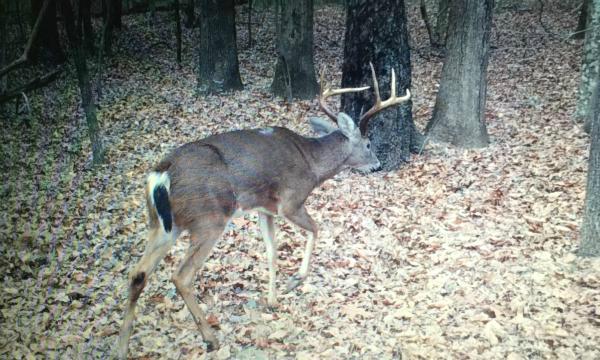
The rut is a term used to describe a specific period each year when mature female deer (commonly called does) go into heat and bucks attempt to mate. Does go into estrus, and bucks become much more aggressive towards each other for mating rights. Typically, the larger, older bucks will battle with younger bucks over females, and the winner secures the right to mate.
The rut an important period for deer hunting because it’s one of the few times that bucks of all ages let down their guard and spend a significant about of time searching out does ready to breed. It’s also the prime time of hunting season where most mature bucks are harvested.
Three Phases of Buck Behavior
Now that I’ve briefly covered the rut, let’s revisit the three annual phases of a mature buck in more detail, focusing on the question about scaring the deer away.
Before the Rut
Before the rut starts, bucks and does may form a herd and will travel and feed together. During this phase, does and young bucks (and when I say a young buck, I’m talking about a buck that less than two years old) will visit and eat at a feeding station and don’t seem to have any fear of feeding at an automated feeder.
I have caught mature bucks on camera feeding at an automated feeder, but it’s nearly always at night or outside of legal shooting hours. In the situations where I have seen them on camera, mature bucks seem very skittish and don’t want to stand or feed too close to the feeder. They usually feed at the feeder’s very edge and eat as far away from the feeder as possible.
During the Rut
While a mature buck’s behavior changes significantly during the rut, I haven’t found them to feed at an automated feeder during this period either.
However, during the rut, I catch far more mature buck pics on camera at feeders (all kinds of feeders), although they do not appear to be there to feed.
It appears that, during the rut, mature bucks are visiting feeder locations or at least checking them out in hopes of finding a receptive doe.
In most cases, I catch them big boy bucks right on the edge of the feeders, and they display one of two behaviors:
- They cruise right through at a good pace and clearly have no interest in feeding.
- They approach the feeder with their nose to the ground, trying to pick up the scent of a hot doe.
In all my years of collecting trail cam pics at feeders, I’ve yet to see a mature buck stop and feed at an automated feeding station during the rut.
Post Rut
Post rut can be a problematic time for mature bucks for several reasons:
- With the biological drive to mate running their lives, mature bucks have not been eating well during the rut and are typically malnourished.
- Also, they are typically drained from all the physical activity that they did, hunting and chasing females during the rut phase.
- Depending on the geography, the rut may end in winter, where natural food sources are at an all-year low.
Many will have lost weight by the time the rut is over and desperately need to refuel. This time period makes them more susceptible to disease and sickness.
The post-rut, especially in winter areas with snow, is the one time when I occasionally get pics of a mature buck eating at a feeder during daylight hours. I catch far more on camera at night, but I think the drive to feed is so great that they are occasionally willing to risk eating at an automated feeder during daylight.
Very much like the pics I’ve gotten in the Pre-Rut stage, most Post-Rut trail camera images I get of mature bucks at a feeder have them standing just on the very outside edge of the feed pattern. In those pictures, they appear to eat as much as possible, but only for a very short time, then move on.
Does the Type of Feeder Matter for Mature Bucks?
I’ve always found this to be an interesting sub-topic because my experience has been that the type of feeder does seem to matter with big boy bucks.
For example, I have far more trail camera pics of nice bucks feeding at gravity feeders (also commonly called corn feeders) and even hanging broadcast feeders on a timer than I have with them feeding at an automated tripod-style feeder on a timer. Another interesting observation is that I had far more images of nice bucks feeding at a gravity-style feeder than I do of any other type of feeding station.
The only other feeder type scenario set-up that I’ve tested that has also produced some images of big bucks who were actually feeding is the traditional corn pile where I just threw out handfuls of corn in a specific area in front of a trail camera.
However, I find that trail cameras placed on game trails and placed at active scrapes produce far more pics of mature bucks compared to any of my deer feeding stations.
Looking at Feeders From a Different Perspective
When I have this conversation at my day job about mature bucks not coming around automatic feeders with interested customers, it usually triggers a series of follow-up questions asking things like:
- Then what’s the point of a feeder if bucks don’t come to it?
- Why invest the time and money in a feeder if it’s not going to offer a shot at a big buck?
- So why even invest the money on feed and feeders then?
Those are understandable questions, especially if you are new to deer hunting or just getting started in the sport. Still, it is essential to think about feeders or a supplemental feeding program as a small part of a bigger picture.
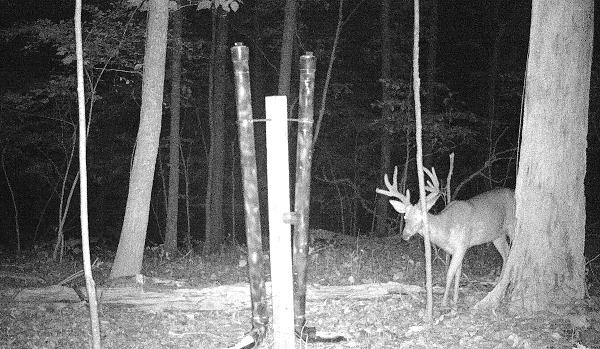
I’ve always looked at deer feeding stations as offering the following hunting benefits:
- The main goal of a feeder is to keep the deer returning to a specific area, so you have an opportunity to hunt them.
- By keeping the all-important does returning time and time to eat at a feeder, when the rut comes around, you have a much greater chance of seeing a big buck while he’s chasing does in the area of your feeder or feeders.
- By offering supplemental food during the winter, you are helping the local deer population survive to be ethically hunted for future generations of hunters.
FAQS
Here are some frequently asked questions that I see being associated with the question about deer being scared of automatic feeders:
Do mature bucks avoid feeders?
Based on my experience, I wouldn’t exactly say that big, mature bucks altogether avoid feeders, but I believe they are very cautious and skittish when approaching one. I also think that if a mature buck can locate other easy-to-find sources of food or food plots, he will take that food over the fear of approaching a feeder.
However, there are very few absolutes in deer hunting, so there are exceptions to every rule. As I mentioned previously:
- I have seen big bucks visit deer feeding stations during the rut in search of does.
- I have also seen big bucks feed at a feeder, but it is mostly at night or outside of legal hunting hours.
- I have seen a few mature bucks come to a gravity-based feeder post-rut to feed.
Why do deer only come to my deer feeder at night?
That’s a tricky question to answer as there are several potential reasons that deer would only visit a feeder at night:
Hunting pressure
While deer can adapt to most anything, I’ve seen situations with my own feeders where hunting pressure creates a problem where deer only hit my feeders at night.
Before one deer season, I had a herd of 15 to 20 deer on my lease that I routinely saw on trail cams and had patterned pretty well. Within that herd were two very nice bucks that I had left alone for several seasons, and they had matured quite well. Both were on my hit list.
A group of hunters leased a piece of property next to my hunting lease and immediately started hunting on the opening day of gun season. Apparently, their preferred way to hunt was through mini-deer drives. It sounds like they formed a skirmish line and then made as much noise as possible to drive the deer in a specific direction. These drives seem to take place at least twice a day, and I did hear what sounded like a few deer being harvested.
I hunted hard on opening day (morning and evening) but had no luck. Saw several does but not either of the two bucks I wanted. I hunted a few more times in the evenings on the opening week but saw fewer and fewer deer.
By the second Saturday of the season, I didn’t see a single deer for the morning or evening. Wondering what was going on, I quietly slipped back in on Sunday morning and pulled all the cards from my cameras. After reviewing the pics, it didn’t take long to figure out why I was not seeing any deer. The deer had transitioned to after dark feeding only.
I’m relatively confident that the hunting pressure from the nearby deer drives (and probably the noise associated with it) was causing the deer to only feed at night.
Spooking the deer when refilling the feeder or when checking the cameras
If you check the cameras too much or refill the feeders too often, it can push the deer into coming to the feeder only after dark.
I learned this lesson the hard way when I first started hunting and work very hard to be as quiet as possible when I come in to refill the feeders or to check the cameras. If it’s a situation where I can’t be quiet (like having to ride a four-wheeler in), I try to do whatever needs to be done as fast as possible, so I’m in and out as quickly as I can.
Competition from other species
Whitetail deer as a species are fairly timid and easily frightened. The lone exception is Whitetail bucks during the rut as they are jacked up on hormones and just spoiling for a fight.
In some cases, other species of animals who visit the feeder can directly or indirectly push the deer away to the point where the deer will only come in at night to avoid conflict.
I’ve seen this happen a few times with wild pigs, raccoons, and even squirrels. Those species will either show in large enough numbers or get close enough to the deer to make them sufficiently uncomfortable, so they leave.
I have trail camera pics showing four does and two fawns being pushed off a feeder by 16 squirrels. At least that’s how many I counted in the pics at one time. Looking at the pics, it appeared that the sheer number of squirrels milling around at the feeder and fighting each other for corn was enough to push the deer away.
If this happens enough, the deer may opt to visit the feeder after dark when there may be less competition at the feeder.
Feeder placement
The feeder’s location can also play a role in this, especially if the deer do not feel safe around the feeder. For example, historically, I’ve seen far fewer deer visit a feeder located in the middle of a field versus a feeder located in the edge of the field. Why? My theory is the edge of the field offers some cover that the deer can flee into if disturbed.
How long does it take for a deer to get used to a feeder?
In my opinion, the answer to that question varies based on the following factors:
- Hunting pressure or human exposure
- Time of year then the feeder is set-up
In locations where the deer face hunting pressure, it may take anywhere from 6-8 weeks before deer become “comfortable” with a feeder and will visit it regularly. In areas where deer have little human contact other than dodging the occasional vehicle and face little to no hunting pressure, they seem to find and adapt to a feeder in a shorter period of time.
The time of year that the feeder is set-up can also play a role in this question. My experience has been that feeders established or set up in the summer months before hunting season can take months before the deer locate the feeder and begin using it. I’ve always attributed this to the high volume of natural food sources available in the Spring and Summer months.
I’d say that, on average, when I set up a new feeder or move an existing feeder, the deer seem to get comfortable with it around the 4-week mark. They will usually locate the feeder sooner, but it seems to take around four weeks or so before the feeder is being visited by deer daily.
